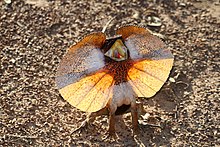Our website is made possible by displaying online advertisements to our visitors.
Please consider supporting us by disabling your ad blocker.
Frilled lizard
| Frilled lizard | |
|---|---|

| |
| Scientific classification | |
| Domain: | Eukaryota |
| Kingdom: | Animalia |
| Phylum: | Chordata |
| Class: | Reptilia |
| Order: | Squamata |
| Suborder: | Iguania |
| Family: | Agamidae |
| Subfamily: | Amphibolurinae |
| Genus: | Chlamydosaurus Gray, 1825 |
| Species: | C. kingii
|
| Binomial name | |
| Chlamydosaurus kingii Gray, 1825
| |

| |
| Distribution of Chlamydosaurus kingii | |
| Synonyms[2] | |
| |
The frilled lizard (Chlamydosaurus kingii), also known commonly as the frilled agama, the frillneck lizard, the frill-necked lizard, and the frilled dragon, is a species of lizard in the family Agamidae. The species is native to northern Australia and southern New Guinea and is the only member of the genus Chlamydosaurus. Its common names refer to the large frill around its neck, which usually stays folded against the lizard's body. The frilled lizard grows to 90 cm (35 in) from head to tail tip and can weigh 600 g (1.3 lb). Males are larger and more robust than females. The lizard's body is generally grey, brown, orangish-brown, or black in colour. The frills have red, orange, yellow, or white colours.
The frilled lizard is largely arboreal, spending most of its time in trees. Its diet consists mainly of insects and other invertebrates. It is more active during the wet season, when it spends more time near or on the ground, and is less observed during the dry season, during which it seeks shade in the branches of the upper canopy. It breeds in the late dry season and early wet season. The lizard uses its frill to scare off predators and display to other individuals. The species is considered to be of least concern by the International Union for Conservation of Nature.
Males and females erect their frills during social encounters, which can be seen as a means of communication for the frilled neck lizard. The development of this feature has been linked to not only adaptation but also allometric relationships.[3]
- ^ O'Shea, M.; Allison, A.; Tallowin, O.; Wilson, S.; Melville, J. (2017). "Chlamydosaurus kingii ". IUCN Red List of Threatened Species. 2017: e.T170384A21644690. doi:10.2305/IUCN.UK.2017-3.RLTS.T170384A21644690.en. Retrieved 19 November 2021.
- ^ Chlamydosaurus kingii at the Reptarium.cz Reptile Database
- ^ Cite error: The named reference
Shine90was invoked but never defined (see the help page).
Previous Page Next Page



